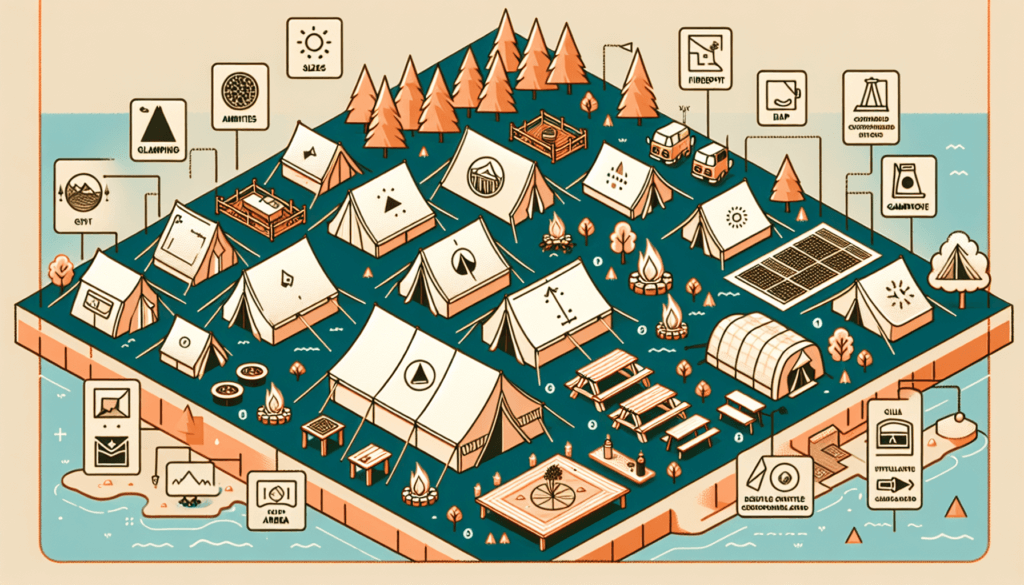Picture this: you’re surrounded by nature, breathing in the fresh air, and enjoying the breathtaking views. You want to immerse yourself in the great outdoors, but you still crave those creature comforts. That’s where glamping comes in. Glamping, short for glamorous camping, offers a luxurious way to experience the beauty of nature without sacrificing comfort. But with so many options available, how do you choose the right glamping tent for your needs? In this article, we’ll guide you through the process of selecting the perfect glamping tent that will make your outdoor getaway unforgettable.

Consider Your Location and Climate
When choosing a glamping tent, one of the first factors you should consider is the weather conditions of your location. Is it hot and dry, or cold and rainy? Understanding the climate will help you choose a tent that can withstand the elements and provide you with a comfortable camping experience.
Once you have assessed the weather conditions, it’s time to determine the specific location where you will be camping. Will you be in a forest, on a beach, or in the mountains? Different terrains require different types of tents, so make sure to choose one that is suitable for your camping location.
Lastly, consider the tent’s suitability for the climate. Some tents are designed to provide extra insulation and protection in extreme weather conditions, while others are more suitable for mild climates. Take into account the temperature ranges and weather patterns of your camping destination to ensure you choose a tent that will keep you comfortable.
Determine Your Budget
Setting a budget range is an essential step in choosing the right glamping tent. Consider how much you are willing to spend on your tent and stick to that range when making your purchase. It’s helpful to research the average price range for tents that meet your requirements to ensure you are getting a fair deal.
When considering your budget, it’s important to think long-term. While it may be tempting to go for the cheapest option available, investing in a high-quality tent can save you money in the long run. A durable tent will last for many camping trips to come, while a cheaper, less reliable option may need to be replaced sooner.
In addition to the tent itself, factor in additional costs such as tent accessories and maintenance. These may include a footprint for added protection, a rainfly for extra waterproofing, or replacement parts if any components of the tent get damaged.

Decide on Tent Size and Capacity
Assessing the number of occupants is crucial in determining the size and capacity of the glamping tent you need. Consider how many people will be sleeping in the tent and whether you will need additional space for gear or activities. It’s better to have a slightly larger tent than to feel cramped and uncomfortable during your camping trip.
The tent dimensions also play a role in the decision-making process. Consider the height, length, and width of the tent to ensure it can accommodate the occupants and provide enough room for movement. It’s essential to have a tent that allows you to stand up comfortably and move around without feeling restricted.
Along with size, evaluate the tent’s layout and floor plan. Some tents offer separate sleeping areas or partitions for added privacy, while others have an open plan design. Think about your preferences and the dynamics of your group when choosing a tent layout that fits your needs.
Choose the Right Tent Material
Understanding the different tent materials is important when selecting a glamping tent. Common materials include nylon, polyester, and canvas, each with its own advantages and disadvantages.
Consider the durability and weight of the tent material. If you plan to camp in rough terrains or frequently go on camping trips, a sturdy and robust material like canvas may be a good option. However, if you prioritize lightness and ease of transportation, nylon or polyester might be more suitable.
The tent material should also be evaluated based on its suitability for different climates. Some materials may be better at insulating against cold weather, while others may excel at keeping you cool on hot summer days. Choose a tent material that will provide adequate protection and comfort based on the climate conditions you expect to encounter.

Consider Tent Setup and Portability
Ease of setup is an important factor to consider, especially if you plan on camping frequently. Look for a glamping tent that can be set up quickly and effortlessly, without the need for complicated instructions or excessive tools. This way, you can spend more time enjoying your camping experience and less time struggling with tent poles and stakes.
Portability and weight are also key considerations, especially if you plan on moving around frequently during your camping trips. A lightweight tent can be a lifesaver when hiking long distances or when you have limited space in your vehicle. Consider the weight and size of the tent when packed to ensure it fits your transportation needs.
Additionally, consider any extra features that may enhance your camping experience. Some glamping tents come with detachable rooms, allowing for more flexibility in space usage. Others may have awnings or vestibules that provide additional shade or storage space. These extra features can greatly enhance your comfort and convenience while camping.
Assess Tent Durability and Longevity
When investing in a glamping tent, it’s crucial to check the construction quality of the tent. Look for sturdy seams, strong zippers, and durable materials that will withstand frequent use and the rigors of the outdoors. A well-constructed tent is less likely to develop leaks or tears, ensuring a longer lifespan.
Pay special attention to the strength of the tent’s frame and poles. They should be able to withstand strong winds and support the weight of the tent itself. Opt for materials like aluminum or fiberglass, which offer a good balance of strength and weight.
Evaluate the tent’s resistance to wind, rain, and UV rays. A waterproof tent with proper seam sealing and a quality rainfly will keep you dry during rain showers. Additionally, look for UV-resistant materials that will protect you from the harmful effects of the sun’s rays, especially if you frequently camp in sunny locations.

Evaluate Ventilation and Condensation Management
Proper ventilation is essential for a comfortable camping experience. Assess the tent’s ventilation options, such as mesh panels and vents, which allow for adequate airflow. Good ventilation helps prevent condensation buildup, reducing the risk of waking up to a damp and uncomfortable environment.
Consider the presence of mesh panels on the tent walls and doors. These allow for increased airflow while keeping insects and bugs out. Vents on the rainfly or roof of the tent can also help regulate temperature and reduce condensation.
Evaluate the tent’s condensation management features. Some tents have specialized coatings or materials that help minimize condensation buildup, keeping the interior dry and comfortable. This is especially important in humid or rainy climates.
Consider Tent Accessibility and Privacy
When it comes to accessibility, consider the number and design of doors and windows in the glamping tent. Multiple doors provide convenient entry and exit points, especially in larger tents where occupants may be spread out. Windows allow for natural light and views, creating a more enjoyable camping experience.
Assess the presence and design of partitions within the tent. If privacy is important to you, look for tents that offer separate sleeping areas or partitions that can be closed off. This allows for privacy even when sharing the tent with others.
Consider the level of privacy provided by the tent. Some tents have opaque walls, while others have transparent or semi-transparent materials. Choose a tent that aligns with your personal preferences for privacy and openness.

Review User Reviews and Recommendations
Before making a final decision, it’s valuable to read customer reviews and ratings of glamping tents. This will give you insights into the experiences of other campers and help you understand the pros and cons of different tent models. Look for reviews that mention durability, ease of setup, and overall satisfaction with the tent’s performance.
Consider recommendations from experienced campers. If you have friends or family members who are avid campers, ask for their recommendations. They can provide valuable insights based on their own experiences and help you make an informed decision.
Research reputable brands and manufacturers. Look for companies with a proven track record of producing quality camping gear. Established brands often have a wide range of tent options to choose from and are more likely to offer reliable customer support.
Check Warranty and After-Sales Support
Review the warranty coverage of the glamping tent you are considering. A good warranty will protect you against manufacturing defects and provide peace of mind knowing that the manufacturer stands behind their product. Pay attention to the duration of the warranty and any specific conditions or exclusions.
Consider the manufacturer’s after-sales support. It’s helpful to choose a company that offers responsive customer service and readily available replacement parts. In the event that something goes wrong with your tent, it’s important to have a reliable point of contact for assistance and support.
Understand the return and exchange policy of the tent. Should you need to return or exchange your tent for any reason, it’s important to know the company’s policy to avoid any surprises or difficulties. Take note of any time limits, restocking fees, or return shipping costs that may apply.
In conclusion, choosing the right glamping tent requires careful consideration of various factors. By assessing your location and climate, determining your budget, deciding on tent size and capacity, considering the tent material, evaluating tent setup and portability, assessing durability and longevity, evaluating ventilation and condensation management, considering tent accessibility and privacy, reviewing user reviews and recommendations, and checking warranty and after-sales support, you can make an informed decision and ensure a comfortable and enjoyable glamping experience. Happy camping!


